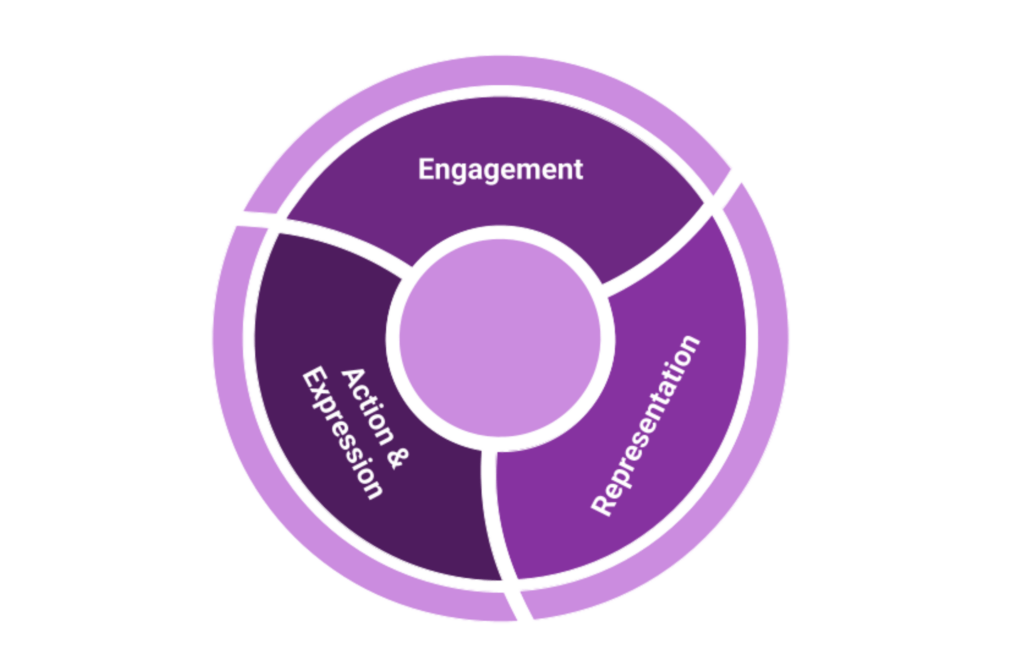For anyone involved with instructional design, it has become increasingly important to ensure that learning experiences are inclusive and accessible to all. Apprenticeships, in particular, play a fundamental role in the UK’s workforce development, providing individuals with the skills and knowledge required to succeed in their chosen professions. One approach to creating inclusive learning experiences is implementing Universal Design for Learning (UDL) principles.

This research-based framework is designed to accommodate the varied needs of all learners, ensuring that apprenticeship delivery caters to the broadest possible range of learning preferences and abilities. In this article, we will discuss the main principles of UDL, explore how it can be applied to apprenticeship delivery, and provide additional key sections to consider when implementing UDL in your apprenticeship programmes.
Principles of Universal Design for Learning
UDL is grounded in three core principles that aim to address the diverse needs of learners. These principles include:
Multiple Means of Representation
Information should be presented in various formats to accommodate learning preferences and sensory needs. This can include text, audio, video, and graphical representations, ensuring that apprentices can access and engage with content that best suits their needs.
Let’s consider this as an example of a Network Cable Installer Apprenticeship. In a network cable installer apprenticeship, incorporating multiple means of representation is pivotal for accommodating different learning preferences and sensory needs. By presenting information in various formats, apprentices can access and engage with the content in a way that best suits their needs. Here are some strategies to apply multiple means of representation in a network cable installer apprenticeship:
| Text-based resources | Provide written materials such as manuals, handbooks, and step-by-step guides for cable installation, cable termination, and troubleshooting tasks. These resources will enable apprentices who prefer to learn through reading to access and review information at their own pace. |
| Audio resources | Offer audio recordings of lectures or instructional materials that explain concepts like network topology, health and safety, and industry standards. This will cater to auditory learners and provide an alternative way to engage with the content. |
Videos | Share video tutorials demonstrating essential skills like cable installation, testing, and maintenance. By visually showing the processes, apprentices can better understand the techniques and procedures involved. This is particularly helpful for visual learners or those who prefer to see practical demonstrations. |
Graphical representations | Utilise diagrams, flowcharts, and schematics to visually represent complex concepts like network architectures, cable configurations, and signal flow. This will help apprentices grasp abstract ideas more easily and provide a visual reference to be consulted during practical tasks. |
Hands-on training | Incorporate practical, hands-on training sessions where apprentices can apply their knowledge and practice essential skills in a real-world setting. This experiential learning will cater to kinesthetic learners who prefer to learn by doing. |
Interactive simulations | Introduce interactive simulations or virtual training environments that allow apprentices to practice installation, troubleshooting, and maintenance tasks in a safe and controlled setting. This can be especially beneficial for those needing additional practice or prefer to learn through trial and error. |
Providers can create an inclusive learning environment that caters to the diverse needs of all apprentices by implementing multiple means of representation in a network cable installer apprenticeship. This will ultimately enhance apprentices’ understanding of the subject matter, improve their skill acquisition, and increase their chances of success in the programme.
Multiple Means of Engagement
Encouraging interest, motivation, and autonomy is essential for successful learning. By providing diverse learning activities and creating supportive environments, apprentices can remain engaged and motivated throughout their programme.
For example, it is essential to provide apprentices with diverse opportunities to demonstrate their understanding and skills in a marketing assistant apprenticeship. By offering a variety of assessment methods, apprentices can express their learning in a manner that aligns with their strengths and preferences. Here are some strategies to apply multiple means of action and expression in a marketing assistant apprenticeship:
| Practical demonstrations | Allow apprentices to showcase their skills through practical tasks, such as creating marketing materials, managing social media accounts, or conducting market research. This hands-on approach enables apprentices to apply their knowledge in real-world scenarios, particularly useful for those who excel in practical tasks. |
| Written assessments | Utilise written assessments, such as reports, case studies, or marketing plans, to evaluate apprentices’ understanding of marketing concepts, strategies, and techniques. This format enables apprentices who prefer written communication or excel in analytical thinking to demonstrate their knowledge effectively. |
| Reflective discussions | Encourage apprentices to engage in reflective discussions with their mentors, peers, or supervisors about their learning experiences, challenges faced, and progress made. This assessment method allows apprentices to develop critical thinking skills and express their understanding of marketing through dialogue and self-reflection. |
| Presentations | Offer opportunities for apprentices to deliver presentations on marketing topics, campaigns they have worked on, or insights gained from their experiences. This method allows apprentices to practice communication skills while demonstrating their understanding of marketing concepts and strategies. |
| Group projects | Assign group projects where apprentices collaborate with their peers to develop and execute a marketing campaign or solve a marketing-related problem. This assessment method promotes teamwork, communication, and problem-solving skills while allowing apprentices to demonstrate their understanding and application of marketing principles in a collaborative setting. |
| ePortfolio | Encourage apprentices to create an ePortfolio, showcasing their work, achievements, and reflections throughout their apprenticeship. This method lets apprentices document their learning journey and demonstrate their professional growth in a personalised and creative format. |
Providers can create an inclusive assessment environment that caters to the diverse needs of all apprentices by implementing multiple means of action and expression in a marketing assistant apprenticeship. This will ultimately enhance apprentices’ engagement, promote a deeper understanding of the subject matter, and increase their chances of success in the programme.
Multiple Means of Engagement
Building interest, motivation, and autonomy is essential for successful learning. By providing diverse learning activities and creating supportive environments, apprentices can remain engaged and motivated throughout their programme.
Let’s use the team leader apprenticeship as an example. Developing interest, motivation, and autonomy can be decisive for successful learning in a team leader apprenticeship. Providing diverse learning activities and creating supportive environments will ensure that apprentices remain engaged and motivated throughout their programme. Here are some strategies to apply multiple means of engagement in a team leader apprenticeship:
| Real-world scenarios | Use real-world examples and case studies to illustrate leadership concepts and principles, making the learning experience more relevant and relatable. This approach helps apprentices to see the practical applications of the skills they are learning, increasing their motivation to acquire and apply those skills. |
| Interactive activities | Incorporate interactive learning activities like role-playing exercises, group discussions, and problem-solving tasks. These activities can help apprentices actively engage with the subject, promoting a deeper understanding of team leadership concepts and practices. |
| Mentorship and peer support | Pair apprentices with experienced team leaders or peers who can offer guidance, advice, and support throughout the programme. This mentorship system can help apprentices feel more connected to their learning community, generating a sense of belonging and motivation to succeed. |
| Self-directed learning | Provide opportunities for self-directed study and exploration to encourage apprentices to take ownership of their learning. This includes independent research, online learning modules, or workshops and seminars. Self-directed learning promotes autonomy and allows apprentices to pursue their interests within the field of team leadership. |
Goal setting and progress monitoring | Assist apprentices in setting realistic and achievable learning and professional development goals. Regularly review and discuss their progress towards these goals, providing constructive feedback and encouragement. This process can help apprentices stay focused, motivated, and accountable for learning. |
| Varied learning environments | Offer learning experiences in various environments, such as classroom-based sessions, online learning, and on-the-job training. By diversifying the learning environment, apprentices can remain engaged and stimulated throughout the programme. |
Recognition and rewards | Acknowledge and celebrate apprentices’ achievements and progress. This can include providing constructive feedback, offering certificates of completion, or celebrating milestones in their apprenticeship. By recognising and rewarding success, apprentices will feel more motivated to continue learning and developing their leadership skills. |
Providers can create an inclusive and stimulating learning environment that caters to the diverse needs of all apprentices by implementing multiple means of engagement in an apprenticeship. This will ultimately enhance apprentices’ interest, motivation, and autonomy, promoting a deeper understanding of team leadership and increasing their chances of success in the programme.
Applying UDL to Apprenticeship Delivery: Strategies for Success
Incorporating UDL principles into apprenticeship delivery can significantly enhance the learning experience for all apprentices. By applying the following strategies, providers can ensure that their apprenticeship programmes cater to the diverse needs and preferences of their learners:
- Adaptable Content: Present content in multiple formats, such as text, video, audio, and interactive simulations. This will ensure that all apprentices can access information most appropriately for their learning preferences and needs. For example, offer online tutorials, downloadable documents, and multimedia resources to create a rich and varied learning environment.
- Flexible Assessment Methods: Utilise various assessment methods, including practical demonstrations, written assessments, and reflective discussions, to allow apprentices to demonstrate their skills and understanding in various ways. This flexibility enables learners to showcase their knowledge in a manner that best aligns with their strengths and preferences, ultimately providing a more accurate and inclusive assessment of their abilities.
- Personalised Learning Pathways: Encourage apprentices to follow individualised learning pathways tailored to their needs and interests. This can be achieved by providing optional modules, self-directed learning opportunities, and personalised support. By allowing apprentices to choose from various learning experiences, they can focus on areas of interest or need, leading to increased engagement and motivation.
- Collaboration and Communication: Promote regular interactions and collaboration between apprentices, trainers, and employers. This can be facilitated through group activities, online discussion forums, and regular progress meetings. Breeding open communication and collaboration helps to create a supportive learning environment where apprentices feel comfortable asking questions, sharing ideas, and seeking assistance when needed.
- Accessible Technology: Employ assistive technology and accessible digital resources to support all learners, ensuring that content is available in multiple formats and can be easily navigated by all apprentices. This includes using screen readers, captioning videos, and ensuring that digital resources are compatible with various devices and platforms. By making content accessible to all learners, providers can create an inclusive learning environment that promotes equal access to information and opportunities for success.
Implementing these strategies in apprenticeship delivery can help apprenticeship providers create an inclusive and supportive learning environment that aligns with the principles of UDL. This will ensure that all apprentices have the opportunity to succeed in their chosen field, regardless of their learning preferences or needs, ultimately contributing to a more skilled and diverse workforce.
Benefits of UDL in Apprenticeship Delivery
Implementing UDL principles in apprenticeship delivery can lead to numerous positive outcomes for apprentices, providers, and employers.
By creating inclusive and accessible learning environments, providers can ensure that all apprentices have the opportunity to succeed, regardless of their learning preferences or needs. Some of the key benefits of incorporating UDL into apprenticeship delivery include the following:
- Increased Retention: By accommodating diverse learning needs and preferences, UDL can help to reduce the dropout rate among apprentices. Learners who feel supported and engaged in their apprenticeship programme are likelier to persist and complete their training. This results in higher retention rates, benefiting both apprentices and employers by reducing the costs associated with high attrition.
- Enhanced Engagement: UDL promotes active engagement by offering apprentices multiple ways to access, process, and demonstrate their understanding of the subject matter. When engaged and motivated, apprentices are more likely to be invested in their learning, leading to improved outcomes and greater accomplishment.
- Improved Completion Rates: Incorporating UDL principles into apprenticeship delivery can contribute to higher successful completion rates by providing apprentices with the necessary support and resources to overcome learning barriers. By addressing the diverse needs of all learners, providers can help to ensure that apprentices have the tools and opportunities required to achieve their goals.
- Greater Inclusivity: UDL furthers a more inclusive learning environment that values and accommodates diversity. Providers can promote a more equitable and inclusive workforce by ensuring all apprentices have equal access to information and learning opportunities, ultimately contributing to a more diverse and representative talent pool.
- Personalised Learning Experiences: UDL enables apprentices to follow personalised learning pathways tailored to their needs and interests. This can increase motivation, satisfaction, and a deeper understanding of the subject, as apprentices can focus on the most relevant and meaningful areas.
- Enhanced Skill Acquisition: By providing multiple means of representation, action and expression, and engagement, UDL supports apprentices in acquiring a diverse range of skills and competencies. This benefits the apprentices and their employers, who gain access to a workforce with a more comprehensive skill set.
In conclusion, the benefits of implementing UDL principles in apprenticeship delivery are numerous and far-reaching. By creating inclusive and accessible learning experiences, providers can help ensure that all apprentices can succeed, regardless of their background or learning needs. This ultimately contributes to a more skilled, diverse, and resilient workforce, benefiting individuals, businesses, and the wider economy.



